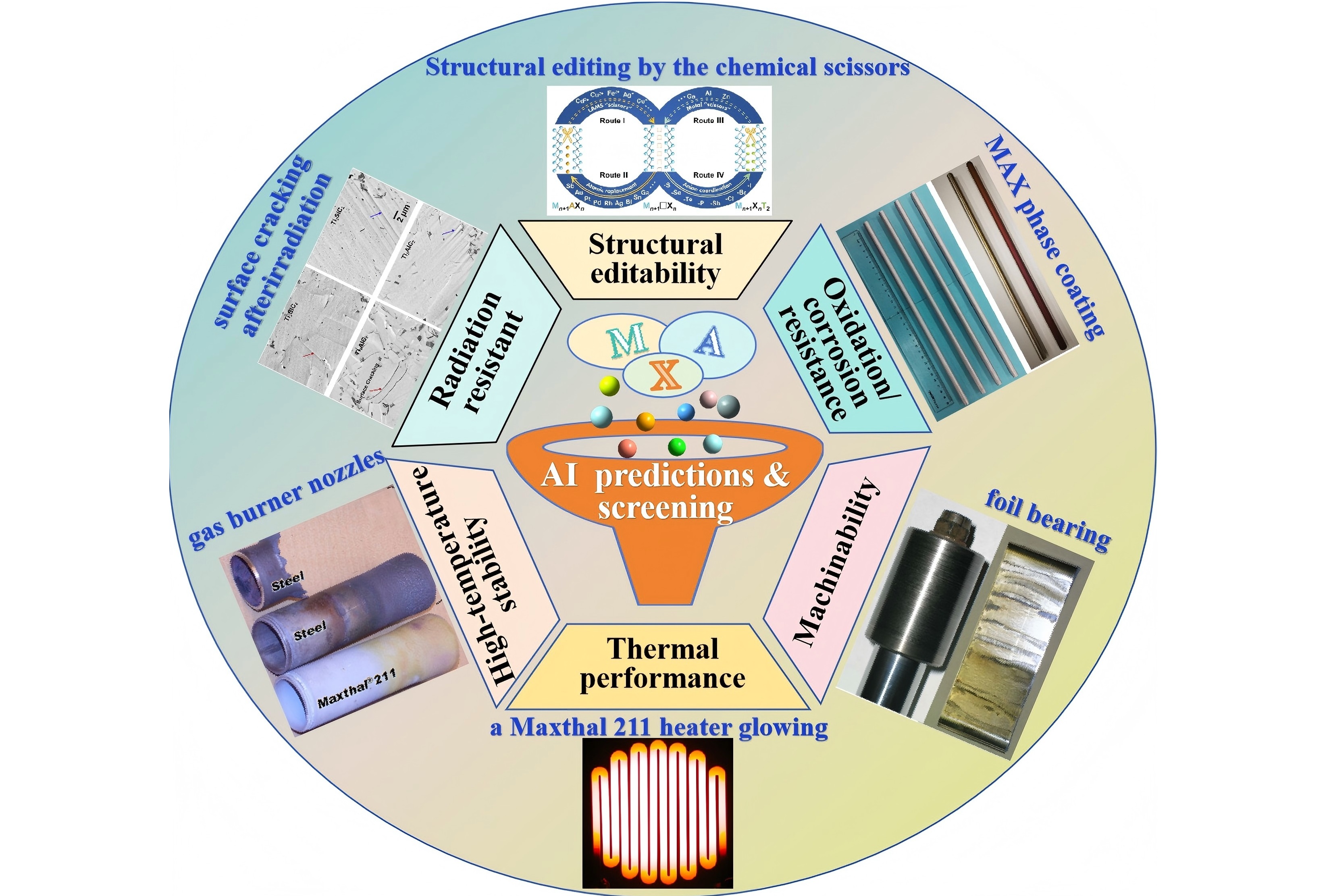Volumes & Issues
Contact
For any inquiries regarding journal development, the peer review process, copyright matters, or other general questions, please contact the editorial office.
Editorial Office
E-Mail: aimat@elspub.com
For production or technical issues,please contact the production team.
Production Team
E-Mail: production@elspub.com
No items found.
Electronic structure and nuclear-environment applications of MAX phases: a theoretical perspective
Received: 26 Feb, 2025
Accepted: 19 Mar, 2025
Published: 31 Mar, 2025
MAX phases, a family of ternary layered carbide and nitride compounds characterized by their atomic-scale hybridization of metallic and covalent-ionic bonding, have emerged as potential materials for extreme environments, including fusion reactor cladding and ultrahigh-temperature sensing. Despite a twofold increase in known compositions over the past five years, the discovery and application of novel MAX phases remain hindered by metastable phase competition under non-equilibrium synthesis, inefficiencies in experimental synthesis/characterization, and ambiguous performance metrics under extreme conditions (e.g., high temperatures, irradiation). Recent breakthroughs in computational materials science — notably high-throughput density functional theory (HT-DFT) and machine learning (ML) — have revolutionized the exploration of these materials by enabling predictive screening of stability and performance. This review systematically analyzes advances in theoretical understanding of MAX phases, focusing on three pillars: electronic structure, thermodynamics and irradiation performance. Finally, brief insights into the challenges and future opportunities for the MAX phases are provided.
Integrating AI and material science: MXene synthesis, preparation, and applications
Received: 07 Oct, 2024
Accepted: 23 Dec, 2024
Published: 21 Jan, 2025
Recent research on two-dimensional anion exchange membranes has highlighted the potential of MXene-based anion exchange membranes in advanced applications. This review provides a comprehensive summary of the preparation strategies for high-quality MXene materials, including methods such as hydrofluoric acid (HF) etching, electrochemical processes, hydrothermal synthesis, and artificial intelligence (AI)-assisted approaches. Various film-forming techniques, such as vacuum filtration, casting, electrospinning, and AI-driven neural network optimization, are also discussed for their role in producing uniform and stable MXene membranes. A detailed examination of interlayer spacing regulation reveals its critical influence on ion exchange membrane performance, particularly with regard to ion transport mechanisms, rates, pathways, selective permeability, and membrane stability. AI has emerged as a transformative tool in this domain, significantly enhancing material discovery and optimization processes by improving synthesis efficiency and tailoring properties for specific applications. The review further explores advanced strategies for interlayer spacing regulation, including surface functionalization, intercalation chemistry, composite formation with nanomaterials and polymers, and predictive modeling using neural networks. Beyond conventional applications in energy storage and catalysis, MXene materials demonstrate exceptional promise in AI-related fields due to their outstanding electrical conductivity, tunable surface chemistry, and mechanical flexibility. These properties position MXenes as key enablers for next-generation AI hardware systems, such as neuromorphic computing, intelligent sensing, and data storage. This work underscores the importance of integrating MXene research with AI to drive future advancements in both materials science and emerging technologies.
Data-efficient and interpretable inverse materials design using a disentangled variational autoencoder
Received: 28 Sep, 2024
Accepted: 06 Dec, 2024
Published: 17 Dec, 2024
Inverse materials design has proven successful in accelerating novel material discovery. Many inverse materials design methods use unsupervised learning where a latent space is learned to offer a compact description of materials representations. A latent space learned this way is likely to be entangled, in terms of the target property and other properties of the materials. This makes the inverse design process ambiguous. Here, we present a semi-supervised learning approach based on a disentangled variational autoencoder to learn a probabilistic relationship between features, latent variables and target properties. This approach is data efficient because it combines all labelled and unlabelled data in a coherent manner, and it uses expert-informed prior distributions to improve model robustness even with limited labelled data. It is in essence interpretable, as the learnable target property is disentangled out of the other properties of the materials, and an extra layer of interpretability can be provided by a post-hoc analysis of the classification head of the model. We demonstrate this new approach on an experimental high-entropy alloy dataset with chemical compositions as input and single-phase formation as the single target property. High-entropy alloys were chosen as example materials because of the vast chemical space of their possible combinations of compositions and atomic configurations. While single property is used in this work, the disentangled model can be extended to customize for inverse design of materials with multiple target properties.
No items found.
No items found.
No items found.




